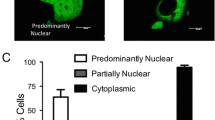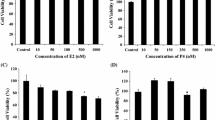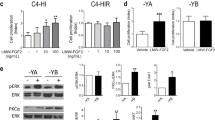Abstract
Over half of breast cancer cases are estrogen-dependent and strategies to combat estrogen-dependent breast cancer have been to either block the activation of estrogen receptor (ER) or diminish the supply of estrogens. Our previous work documented that estrogen-independent expression of progesterone receptor (PR) in MCF-7 cells markedly disrupted the effects of estrogen. In this study, we have developed an adenovirus-mediated gene delivery system to study the specific involvement of PR isoform A (PR-A) and PR-B in the anti-estrogenic effect and its mechanism of action. The results revealed that PR-B, but not PR-A, exhibited distinct anti-estrogenic effect on E2-induced cell growth, gene expression, and ER-ERE interaction in a ligand-independent manner. The anti-estrogenic effect of PR-B was also associated with heightened metabolism and increased cellular uptake of estradiol-17β (E2). We have also found that the B-upstream segment of PR-B alone was able to inhibit E2-induced ER-ERE interaction and cellular uptake of E2. Although PR-A alone did not affect E2-induced ER activity, it antagonized the anti-estrogenic effect of PR-B in a concentration-dependent manner. The findings suggest an important mechanism of maintaining a favorable level of ER activity by PR-A and PR-B in estrogen target cells for optimal growth and differentiation. The potential anti-estrogenic mechanism of PR-B may be exploited for breast cancer therapy.








Similar content being viewed by others
Abbreviations
- E2:
-
Estradiol-17β
- ER:
-
Estrogen receptor
- ERE:
-
Estrogen response element
- PR:
-
Progesterone receptor
- PR-A:
-
PR isoform A
- PR-B:
-
PR isoform B
- Ad/Φ:
-
Control adenovirus
- Ad/PRA:
-
Adenovirus carrying PR-A cDNA
- Ad/PRB:
-
Adenovirus carrying PR-B cDNA
- MCF-7-Ad/Φ:
-
MCF-7 cells infected with Ad/Φ
- MCF-7-Ad/PRA:
-
MCF-7 cells infected with Ad/PRA
- MCF-7-Ad/PRB:
-
MCF-7 cells infected with Ad/PRB
- BUS:
-
B upstream segment
- AF3:
-
Activation function 3
- DBD:
-
DNA binding domain
- VR:
-
Variable region
- NLS:
-
Nuclear location signal
- HPLC:
-
High performance liquid chromatography
- aa:
-
Amino acid
- MOI:
-
Multiplicity of infection
References
Curtis Hewitt S, Couse JF, Korach KS (2000) Estrogen receptor transcription and transactivation: estrogen receptor knockout mice: what their phenotypes reveal about mechanisms of estrogen action. Breast Cancer Res 2:345–352
Conneely OM, Kettelberger DM, Tsai MJ, Schrader WT, O’Malley BW (1989) The chicken progesterone receptor A and B isoforms are products of an alternate translation initiation event. J Biol Chem 264:14062–14064
Kastner P, Krust A, Turcotte B, Stropp U, Tora L, Gronemeyer H, Chambon P (1990) Two distinct estrogen-regulated promoters generate transcripts encoding the two functionally different human progesterone receptor forms A and B. Embo J 9:1603–1614
Takimoto GS, Tung L, Abdel-Hafiz H, Abel MG, Sartorius CA, Richer JK, Jacobsen BM, Bain DL, Horwitz KB (2003) Functional properties of the N-terminal region of progesterone receptors and their mechanistic relationship to structure. J Steroid Biochem Mol Biol 85:209–219
Shyamala G, Yang X, Silberstein G, Barcellos-Hoff MH, Dale E (1998) Transgenic mice carrying an imbalance in the native ratio of A to B forms of progesterone receptor exhibit developmental abnormalities in mammary glands. Proc Natl Acad Sci USA 95:696–701
Shyamala G, Louie SG, Camarillo IG, Talamantes F (1999) The progesterone receptor and its isoforms in mammary development. Mol Genet Metab 68:182–190
Clarke R, Liu MC, Bouker KB, Gu Z, Lee RY, Zhu Y, Skaar TC, Gomez B, O’Brien K, Wang Y et al (2003) Antiestrogen resistance in breast cancer and the role of estrogen receptor signaling. Oncogene 22:7316–7339
Yager JD, Davidson NE (2006) Estrogen carcinogenesis in breast cancer. N Engl J Med 354:270–282
Skildum A, Faivre E, Lange CA (2005) Progesterone receptors induce cell cycle progression via activation of mitogen-activated protein kinases. Mol Endocrinol 19:327–339
Kalkhoven E, Kwakkenbos-Isbrucker L, de Laat SW, van der Saag PT, van der Burg B (1994) Synthetic progestins induce proliferation of breast tumor cell lines via the progesterone or estrogen receptor. Mol Cell Endocrinol 102:45–52
Groshong SD, Owen GI, Grimison B, Schauer IE, Todd MC, Langan TA, Sclafani RA, Lange CA, Horwitz KB (1997) Biphasic regulation of breast cancer cell growth by progesterone: role of the cyclin-dependent kinase inhibitors, p21 and p27(Kip1). Mol Endocrinol 11:1593–1607
Alkhalaf M, El-Mowafy A, Karam S (2002) Growth inhibition of MCF-7 human breast cancer cells by progesterone is associated with cell differentiation and phosphorylation of Akt protein. Eur J Cancer Prev 11:481–488
Lin VC, Ng EH, Aw SE, Tan MG, Chan VS, Ho GH (1999) Progestins inhibit the growth of MDA-MB-231 cells transfected with progesterone receptor complementary DNA. Clin Cancer Res 5:395–403
Lin VC, Eng AS, Hen NE, Ng EH, Chowdhury SH (2001) Effect of progesterone on the invasive properties and tumor growth of progesterone receptor-transfected breast cancer cells MDA-MB-231. Clin Cancer Res 7:2880–2886
Sedlacek SM (1988) An overview of megestrol acetate for the treatment of advanced breast cancer. Semin Oncol 15:3–13
Bezwoda WR, Gudgeon A, Falkson G, Jordaan JP, Goedhals L (1998) Fadrozole versus megestrol acetate: a double-blind randomised trial in advanced breast cancer. Oncology 55:416–420
Giangrande PH, Kimbrel EA, Edwards DP, McDonnell DP (2000) The opposing transcriptional activities of the two isoforms of the human progesterone receptor are due to differential cofactor binding. Mol Cell Biol 20:3102–3115
Katzenellenbogen BS (2000) Mechanisms of action and cross-talk between estrogen receptor and progesterone receptor pathways. J Soc Gynecol Investig 7:S33–S37
Chalbos D, Galtier F (1994) Differential effect of forms A and B of human progesterone receptor on estradiol-dependent transcription. J Biol Chem 269:23007–23012
Zheng ZY, Bay BH, Aw SE, Lin VC (2005) A novel antiestrogenic mechanism in progesterone receptor-transfected breast cancer cells. J Biol Chem 280:17480–17487
Mittereder N, March KL, Trapnell BC (1996) Evaluation of the concentration and bioactivity of adenovirus vectors for gene therapy. J Virol 70:7498–7509
Dai D, Kumar NS, Wolf DM, Leslie KK (2001) Molecular tools to reestablish progestin control of endometrial cancer cell proliferation. Am J Obstet Gynecol 184:790–797
Cao S, Iyer JK, Lin V (2006) Identification of tetratricopeptide repeat domain 9, a hormonally regulated protein. Biochem Biophys Res Commun 345:310–317
Leo JC, Wang SM, Guo CH, Aw SE, Zhao Y, Li JM, Hui KM, Lin VC (2005) Gene regulation profile reveals consistent anticancer properties of progesterone in hormone-independent breast cancer cells transfected with progesterone receptor. Int J Cancer 117:561–568
Sheridan PL, Francis MD, Horwitz KB (1989) Synthesis of human progesterone receptors in T47D cells. Nascent A- and B-receptors are active without a phosphorylation-dependent post-translational maturation step. J Biol Chem 264:7054–7058
Sartorius CA, Melville MY, Hovland AR, Tung L, Takimoto GS, Horwitz KB (1994) A third transactivation function (AF3) of human progesterone receptors located in the unique N-terminal segment of the B-isoform. Mol Endocrinol 8:1347–1360
Tung L, Mohamed MK, Hoeffler JP, Takimoto GS, Horwitz KB (1993) Antagonist-occupied human progesterone B-receptors activate transcription without binding to progesterone response elements and are dominantly inhibited by A-receptors. Mol Endocrinol 7:1256–1265
Vegeto E, Shahbaz MM, Wen DX, Goldman ME, O’Malley BW, McDonnell DP (1993) Human progesterone receptor A form is a cell- and promoter-specific repressor of human progesterone receptor B function. Mol Endocrinol 7:1244–1255
Pratt WB, Galigniana MD, Morishima Y, Murphy PJ (2004) Role of molecular chaperones in steroid receptor action. Essays Biochem 40:41–58
DeFranco DB, Csermely P (2000) Steroid receptor and molecular chaperone encounters in the nucleus. Sci STKE 2000:PE1
Tetel MJ, Giangrande PH, Leonhardt SA, McDonnell DP, Edwards DP (1999) Hormone-dependent interaction between the amino- and carboxyl-terminal domains of progesterone receptor in vitro and in vivo. Mol Endocrinol 13:910–924
Tung L, Shen T, Abel MG, Powell RL, Takimoto GS, Sartorius CA, Horwitz KB (2001) Map** the unique activation function 3 in the progesterone B-receptor upstream segment. Two LXXLL motifs and a tryptophan residue are required for activity. J Biol Chem 276:39843–39851
Robyr D, Wolffe AP, Wahli W (2000) Nuclear hormone receptor coregulators in action: diversity for shared tasks. Mol Endocrinol 14:329–347
Ballare C, Uhrig M, Bechtold T, Sancho E, Di Domenico M, Migliaccio A, Auricchio F, Beato M (2003) Two domains of the progesterone receptor interact with the estrogen receptor and are required for progesterone activation of the c-Src/Erk pathway in mammalian cells. Mol Cell Biol 23:1994–2008
Dong X, Challis JR, Lye SJ (2004) Intramolecular interactions between the AF3 domain and the C-terminus of the human progesterone receptor are mediated through two LXXLL motifs. J Mol Endocrinol 32:843–857
Tung L, Abdel-Hafiz H, Shen T, Harvell DM, Nitao LK, Richer JK, Sartorius CA, Takimoto GS, Horwitz KB (2006) Progesterone Receptors (PR)-B and PR-A Regulate Transcription by Different Mechanisms: Af-3 Exerts Regulatory Control over Coactivator Binding to PR-B. Mol Endocrinol 20:2656–2670
Onate SA, Boonyaratanakornkit V, Spencer TE, Tsai SY, Tsai MJ, Edwards DP, O’Malley BW (1998) The steroid receptor coactivator-1 contains multiple receptor interacting and activation domains that cooperatively enhance the activation function 1 (AF1) and AF2 domains of steroid receptors. J Biol Chem 273:12101–12108
Graham JD, Yager ML, Hill HD, Byth K, O’Neill GM, Clarke CL (2005) Altered progesterone receptor isoform expression remodels progestin responsiveness of breast cancer cells. Mol Endocrinol 19:2713–2735
Sartorius CA, Shen T, Horwitz KB (2003) Progesterone receptors A and B differentially affect the growth of estrogen-dependent human breast tumor xenografts. Breast Cancer Res Treat 79:287–299
Weigel NL, Zhang Y (1998) Ligand-independent activation of steroid hormone receptors. J Mol Med 76:469–479
Jacobsen BM, Schittone SA, Richer JK, Horwitz KB (2005) Progesterone-independent effects of human progesterone receptors (PRs) in estrogen receptor-positive breast cancer: PR isoform-specific gene regulation and tumor biology. Mol Endocrinol 19:574–587
Thornton JW (2001) Evolution of vertebrate steroid receptors from an ancestral estrogen receptor by ligand exploitation and serial genome expansions. Proc Natl Acad Sci USA 98:5671–5676
Thornton JW, Need E, Crews D (2003) Resurrecting the ancestral steroid receptor: ancient origin of estrogen signaling. Science 301:1714–1717
Hopp TA, Weiss HL, Hilsenbeck SG, Cui Y, Allred DC, Horwitz KB, Fuqua SA (2004) Breast cancer patients with progesterone receptor PR-A-rich tumors have poorer disease-free survival rates. Clin Cancer Res 10:2751–2760
Sakaguchi H, Fujimoto J, Hong BL, Nakagawa Y, Tamaya T (2004) Drastic decrease of progesterone receptor form B but not A mRNA reflects poor patient prognosis in endometrial cancers. Gynecol Oncol 93:394–399
Acknowledgments
We thank Prof. Pierre Chambon from the Institute of Genetics and Molecular and Cellular Biology, Strasbourg, France, for providing the expression vectors hPR1 and hPR2, and Prof. Benita S. Katzenellenbogen, University of Illinois at Urbana-Champaign, Illinois, for providing the promoter interference constructs. This work is supported by Ministry of Education, Republic of Singapore (ARC/02) to Valerie C-L. Lin.
Author information
Authors and Affiliations
Corresponding author
Rights and permissions
About this article
Cite this article
Zheng, ZY., Zheng, SM., Bay, BH. et al. Anti-estrogenic mechanism of unliganded progesterone receptor isoform B in breast cancer cells. Breast Cancer Res Treat 110, 111–125 (2008). https://doi.org/10.1007/s10549-007-9711-8
Received:
Accepted:
Published:
Issue Date:
DOI: https://doi.org/10.1007/s10549-007-9711-8




